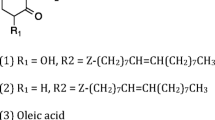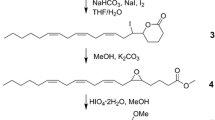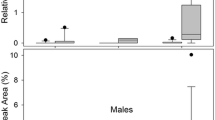Abstract
The pre-excavation activity of the neonate larvae of Cactoblastis cactorum (Lepidoptera: Pyralidae) is typically confined to an arena that encircles the base of their egg stick. If the caterpillars are unable to penetrate the host plant within the arena, they strike off en masse in search of a more favorable site, marking their pathway with secretions from their mandibular glands. One component of this secretion, 4-hydroxy-2-oleoylcyclohexane-1,3-dione (an acylcyclohexanedione, ACHD), has been previously shown to function as a trail pheromone. In this paper, we report the characterization, synthesis, and bioassays of a family of 3-acyl fatty acid methyl esters (which we named cactoblastins), a chemically distinct group of mandibular gland compounds that also elicit trail following behavior. The relative effectiveness in eliciting trail following of the ACHD and six, chemically distinct, synthetic cactoblastins was determined. The most bioactive of the cactoblastins was also compared to whole mandibular gland extract to assess its ability to disrupt the aggregative behavior of the neonates and to serve as a biorational alternative to pesticides for managing invasive populations of the caterpillar.







Similar content being viewed by others
References
Agoramoorthy G, Chandrasekaran M, Venkatesalu V, Hsu MJ (2007) Antibacterial and antifungal activities of Fatty Acid Methyl Esters of the blind-your-eye mangrove from India. Br J Microbiol 38:739–742
Corbet SA (1971) Mandibular gland secretion of larvae of the flour moth, Anagasta kuehniella, contains an epideictic pheromone and elicits oviposition movements in a hymenopteran parasite. Nature 232:481–484
Costa JT (2006) The other insect societies. Harvard University Press, Cambridge
Dickel TS (1991) Cactoblastis cactorum in Florida (Lepidoptera: Pyralidae: Phycitinae). Trop Lepidoptera 2:117–118
Dilika F, Bremner PD, Meyer JJ (2000) Antibacterial activity of linoleic and oleic acids isolated from Helichrysum pedunculatum: a plant used during circumcision rites. Fitoterapia 71(4):450–452
Dodd AP (1940) The biological campaign against prickly pear Commonwealth Prickly Pear Board Brisbane 1–177
Ferreira P, Cardoso T, Ferreira F, Ferreira MF, Piper P, Sousa MJ (2014) Mentha piperita essential oil induces apoptosis in yeast associated with both cytosolic and mitochondrial ROS-mediated damage. FEMS Yeast Res. https://doi.org/10.1111/1567-1364.12189
Fitzgerald TD (1993) Trail following and recruitment: response of eastern tent caterpillar Malacosoma americanum to 5β-cholestane-3-24-dione and 5β-cholestan-3-one. J Chem Ecol 19:449–545
Fitzgerald TD (2008) Use of a pheromone mimic to cause the disintegration and collapse of colonies of tent caterpillars (Malacosoma spp.). J Appl Entomol 211:671–677
Fitzgerald TD, Underwood DLA (1998) Trail marking by the larva of the Madrone butterfly Eucheira socialis and the role of the trail pheromone in communal foraging behavior. J Insect Behav 11:247–263
Fitzgerald TD, Wolfin M, Rossi F, Carpenter JE, Pescador-Rubio A (2014) Trail marking by larvae of the cactus moth, Cactoblastis cactorum. J Insect Sci 14(64):1–15
Fitzgerald TD, Kelly M, Potter T, Carpenter JE, Rossi F (2015) Trail following response of larval Cactoblastis cactorum to 2-acyl-1, 3 cyclohexanediones. J Chem Ecol 41:409–417
Fitzgerald TD, Wolfin M, Young R, Meyer K, Fabozzi E (2016) Collectively facilitated behavior of the neonate caterpillars of Cactoblastis cactorum (Lepidoptera: Pyralidae). Insects 7:59–75
Fitzgerald TD, Carpenter JE, Hight SD (2019) Larval pheromone disrupts pre-excavation aggregation of Cactoblastis cactorum (Lepidoptera: Pyralidae) neonates precipitating colony collapse. Fla Entomol 102:538–543
Gunstone FD, Polard MR, Scrimgeour CM, Vedanayagam HS (1977) Fatty acids. Part 50. 13C nuclear magnetic resonance studies of olefinic fatty acids and esters. Chem Phys Lipid 18:115–129
Habeck DH, Bennett FD (1990) Cactoblastis cactorum Berg (Lepidoptera: Pyralidae), a phycitine new to Florida Florida Department of Agriculture and Consumer Services Division of Plant Industry. Entomol Circ 333:4
Hight SD, Carpenter JE (2009) Flight phenology of male Cactoblastis cactorum (Lepidoptera: Pyralidae) at different latitudes in the south eastern United States. Fla Entomol 92:208–216
Howard RW, Blake JE (2004) Stage-specific suticular lipids of Plodia interpunctella (Lepidoptera: Pyralidae: Phycitinae): 2-acyl-1,3-cyclohexadiones from larval mandibular glands serve as cuticular lipids. Comp Biochem Physiol B 138:193–206
Mudd A (1978) Novel β-triketonos from Lepidoptera. J Chem Soc Chem Commun 23:1075–1076
Mudd A (1981) Novel 2-acylcyclohexane-1,3-diones in the mandibular glands of Lepidopteran larvae. J Chem Soc Trans 1:2357–2362
Mudd A (1983) Further novel 2-acylcyclohexane-1,3-diones from lepidopteran larvae. J Chem Doc Perkin Trans 1:2161–2164
Mudd A, Corbet SA (1982) Response of the ichneumonid parasite Nemeritis canescens to kairomones from the flour moth, Ephestia kuehniella. J Chem Ecol 8:843–850
Mudd A, Walters JHH, Corbert SA (1984) Relative kairomonal activities of 2-acyl cyclohexane-1,3 diones in elicting ovipositional behavior from parasite Nemeritis canescens (Grav.). J Chem Ecol 10:1597–1601
Pettey FW (1947) The biological control of prickly pears in South Africa Science Bulletin, Department of Agriculture of the Union of South Africa 271: 1–163
Pinto MEA, Araújo SG, Morais MI, Sá NP, Lima CM, Rosa CA, Siqueira EP, Johann S, Lima LARS (2017) Antifungal and antioxidant activity of fatty acid methyl esters from vegetable oils. An Acad Bras Cienc 89(3):1671–1681
Vegliante F, Hasenfuss I (2012) Morphology and diversity of exocrine glands inlepidopteran larvae. Ann Rev Entomol 57:187–204
Zimmermann H, Bloem S, Klein H (2004) History, threat, surveillance and control of the cactus Moth, Cactoblastis cactorum. IAEA, Vienna
Acknowledgements
Colonies were maintained in the Cortland facility under APHIS permit P526P-09-00995. James Carpenter and Stephen Hight provided the egg masses of C. cactorum. This research was supported by grants from the USDA-APHIS and from the National Science Foundation (1337695). Katelyn Meyer and Ryan Young assisted in the conduction of the bioassays.
Author information
Authors and Affiliations
Corresponding author
Additional information
Communicated by Marko Rohlfs.
Electronic supplementary material
Below is the link to the electronic supplementary material.
Rights and permissions
About this article
Cite this article
Rossi, F.M., Rojas, D., Cervasio, D.A. et al. Response of the neonate larvae of Cactoblastis cactorum to synthetic cactoblastins, a newly identified class of pheromonally-active chemicals found in the caterpillar’s mandibular glands. Chemoecology 30, 245–253 (2020). https://doi.org/10.1007/s00049-020-00314-4
Received:
Accepted:
Published:
Issue Date:
DOI: https://doi.org/10.1007/s00049-020-00314-4




